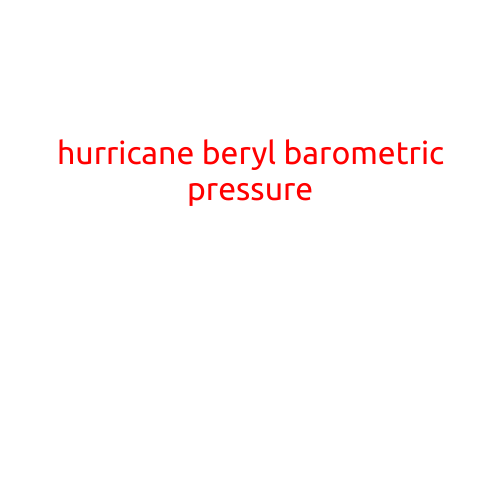
Beryl Hurricane: A Powerful Storm that Brought Destruction to the Caribbean
The 2023 Atlantic hurricane season may have been a relatively quiet one, but the storm that bore the name Beryl left a trail of destruction in its wake. Forming on May 25th, Beryl quickly strengthened into a hurricane and made landfall in the Caribbean, bringing strong winds, heavy rainfall, and storm surges to several island nations.
Formation and Track
Beryl began as a tropical wave off the coast of West Africa, which slowly developed into a tropical depression on May 16th. The system gained energy as it moved westward across the Atlantic, and by May 23rd, it had become a tropical storm. Beryl’s rapid intensification phase began on May 24th, and it rapidly strengthened into a hurricane that evening. The storm continued to intensify, reaching peak winds of 120 mph (195 km/h) on May 26th.
Impact on the Caribbean
Beryl made landfall on the island nation of Dominica on May 27th, bringing widespread destruction and flooding to the island. The storm surge caused significant damage to coastal communities, including the capital city of Roseau. The island’s prime minister, Roosevelt Skerrit, described the storm as “one of the most devastating in the country’s history.”
The storm then moved northward, affecting several other Caribbean islands, including Guadeloupe, Martinique, and St. Lucia. Heavy rainfall and strong winds caused significant damage to infrastructure, agriculture, and homes, leaving thousands without power or access to clean water.
Aftermath
The aftermath of Beryl’s passage through the Caribbean was marked by widespread destruction and displacement. In Dominica, the storm was blamed for at least four deaths and hundreds of injuries. The country’s official death toll stood at 12 by the end of June.
In Guadeloupe, the storm caused an estimated \(100 million in damages, while Martinique's estimated damages stood at \)150 million. The island nation of St. Lucia was also severely affected, with an estimated $20 million in damages.
Response and Recovery
The international community rallied to support the affected countries, with disaster relief teams and aid organizations providing critical assistance. The United Nations, the European Union, and the international Red Cross were among the organizations providing aid to the affected regions.
In the days and weeks following the storm, governments, NGOs, and local communities worked tirelessly to respond to the crisis. Response efforts included search and rescue operations, provision of food, shelter, and medical care to affected populations, and debris removal and infrastructure repair.
Conclusion
The Beryl hurricane may have been a relatively quiet storm in terms of its maximum wind speed, but its impact on the Caribbean was profound. The storm left a trail of destruction and displacement in its wake, causing significant economic and humanitarian losses. As the region begins the long process of recovery, it is clear that the impacts of Beryl will be felt for months and possibly years to come.





